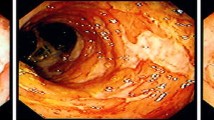Abstract
Amebiasis is the acute and chronic disease produced by Entamoeba histolytica,an entity which occurs in endemic fashion in many of the tropical and subtropical areas of the world, capable of affecting diverse organs of the body, especially the colon. Amebiasis has different clinical forms of presentation, varying from the asymptomatic carrier state to severe, although not frequent, fulminant or necrotizing colitis, characteristically associated with high morbidity and mortality. We hereby report a series of 50 adult patients with fulminating amebic colitis managed at our institution between January, 1971 and July, 1989, with a global mortality of 60%. Early diagnosis, treatment with effective antiamebic agents—specifically metronidazole—and opportune aggressive surgical intervention have resulted in better survival rates. We had no survivors prior to 1970; our current survival rate is still a dismal 40%, indicating the very severe nature of the disease.
Résumé
L'amibiase est une maladie aiguë ou chronique provoquée par l'Entamoeba histolytica; elle se propage de façon endémique dans plusieures pays tropicaux et subtropicaux. Elle peut atteindre de différents organes du corps et, tout particulièrement, le côlon. L'amibiase présente plusieurs formes cliniques, allant de l'état asymptomatique du porteur sain à la colite grave, fulminante ou nécrosante, toutefois peu fréquente mais associée à des taux élevés de morbidité et de mortalité. Nous rapportons dans cet article une série de 50 patients adultes ayant eu une colite amibienne fulminante traités dans notre éstablissement entre janvier 1971 et juillet 1989: le taux global de mortalité était de 60%. Diagnostic précoce, traitement aux agents anti-amibiens efficaces, en particulier le métronidazole, et intervention chirurgicale agressive et adaptée ont donné les meilleurs taux de survie. Nous n'avons eu aucun survivant jusqu'en 1970; notre taux de survie est encore un triste 40%, ce qui traduit encore la nature extrêmement grave de la maladie.
Resumen
La amibiasis es la enfermedad aguda o crónica producida por laEntamoeba histolytica, una entidad clínica que ocurre en forma endémica en muchas regiones tropicales y subtropicales del mundo y que afecta diversos órganos, especialmente el colon. La amibiasis tiene diferentes formas de presentación, las cuales varían desde el estado de portador asintomático hasta la muy severa, aunque poco frecuente, colitis necrotizante o colitis fulminante, la cual, en forma característica, se asocia con elevadas tasas de morbilidad y mortalidad. En este artículo reportamos una serie de 50 pacientes adultos con colitis amibiana fulminante tratados en nuestra institución entre enero de 1971 y julio de 1989, con una mortalidad global de 60%. El diagnóstico precoz, el tratamiento con agentes antiamibianos efectivos, especialmente con metronidazol, y una interventión quirúrgica agresiva y oportuna, han dado como resultado mejores tasas de sobrevida. No tuvimos sobrevivientes antes de 1970; nuestra actual tasa de sobrevida es apenas de 40%, lo cual indica la gravedad de esta enfermedad.
Similar content being viewed by others
References
Losch, F.: Massenhafte Entwicde Lung Von Amoeben in Dickdarm. Arch. F. Path. Anat. U. Physiol.65:196, 1875
Schudinn, F.: Untersuchungen Uber die Fortpflanzung einiger Rhizopoden. ARB a.d.k. Gsndhtsame19:547, 1902-1903
Craig, C.F.: Hemolytic, cytolytic and complement binding properties of extracts of Entamoeba histolytica. Am. J. Trop. Med7:225, 1927
Patterson, M., Schoppe, L.E.: The presentation of amebiasis. Med. Clin. North. Am.66:689, 1982
Alguacil, M.A., Asorey, C.A., Guerra, J.M., Vilalta, L.: Amebiasis invasiva: Etiología, patogenía, epidemiología y trasmisión. Amebiasis intestinal y sus complicaciones. Rev. Clin. Española176:215, 1985
Carrion, W., Torres, C., Karolys, E., Ruiz. G.: Megacolon tóxico. Colitis necrotizante amebiana. Cirugía Cuatoriana5:28, 1989
Luvuno F.M., Mishaliz, Baker, L.W.: Vascular occlusion in the pathogenesis of complicated amebic colitis: Evidence for a hypothesis. Br. J. Surg.72:123, 1985
Cordoba, R.: Perforacion intestinal en la infancia. Anotaciones pediátricas3:239, 1959
Duque, J.O.: Estudio de la amebiasis y otras parasitosis intestinales. Antioquia Medica12:142, 1962
Forril, J., Guarner, V., Lombardo, G.: Cirugía de la amebiasis invasora. Arch. Invest. Med. Mejico2[Suppl.]:437, 1971
Brooks, J., Kozarek, R.: Amebic colitis. Preventing morbidity and mortality from fulminant disease. Postgrad. Med.78:267, 1985
Clark, R., Frost, P.: Fulminating necrotizing amebic colitis with perforation. Case report and review. Can. Med. Assoc. J.128:1424, 1983
Lalama, M.: Perforación amebiana del colon. Trabajo de Residencia, Biblioteca Médica, Universidad de Antioquia, Medellín, 1970
Ellyson, J., Bezmalinovic, A., Parks, S.N., Lewis, F.R.: Necrotizing amebic colitis: A frequently fatal complication. Am. J. Surg.152:21, 1986
Aristizábal, H., Acevedo, J., Botero, M.: Colitis amebiana en el adulto. Acta Méd. Colombiana6:305, 1981
Chen, W.J., Chen K.M., Lin, M.: Colon perforation in amebiasis. Arch. Surg.103:676, 1971
Duque, O.: Amebiasis fatal en Colombia. Antioquia Méd. (Medellin)15:300, 1965
Adams, E.B., MacLeod, I.N.: Invasive amebiasis. Medicine (Baltimore)56:315, 1977
Keystone, J.S., Keystone, D.L., Proctot, E.M.: Intestinal parasitic infections in homosexual men: Prevalence, symptoms, and factors in transmission. Can. Med. Assoc. J.123:512, 1980
Hakansson, C., Thorén, K., Norkans, G.: Intestinal parasitic infection and other sexually transmitted disease in asymptomatic homosexual men. Scand. J. Infect. Dis.16:199, 1984
Vajarabudda, T., Dhitavat, A., Kichananata, B.: Fulminating amebic colitis: A clinical evaluation. Br. J. Surg.66:630, 1979
Simmons, R.L., Howard, R.J.: Surgical Infectious Diseases, New York, Appleton Century Crofts, 1982, p. 59
Wig, J.D., Kaushid, S.P., Saleem, M.A.: Amebic perforation of the colon. Int. Surg.67:486, 1982
Wig, J.K., Talwar, B.L., Bushnurmath, S.R.: Toxic dilatation complicating fulminant amebic colitis. Br. J. Surg.68:135, 1981
Yepes, C.: Lahipotonia del esfínter anal, un signo común en la amebiasis. Bolet. Clín. Méd.9:292, 1947
Blumencranz, H., Kasen, L., Romeu, J.: The role of endoscopy in suspected amebiasis. Am. J. Gastroenterol.78:15, 1983
Babb, R.R., Trollope, M.L.: Acute fulminating amebic colitis. Survival after total colectomy. Gut26:301, 1985
Patterson, M., Healy, G.R., Shabot, J.M.: Serologic testing for amebiasis. Gastroenterology78:136, 1980
Author information
Authors and Affiliations
Rights and permissions
About this article
Cite this article
Aristizábal, H., Acevedo, J. & Botero, M. Fulminant amebic colitis. World J. Surg. 15, 216–221 (1991). https://doi.org/10.1007/BF01659055
Issue Date:
DOI: https://doi.org/10.1007/BF01659055




